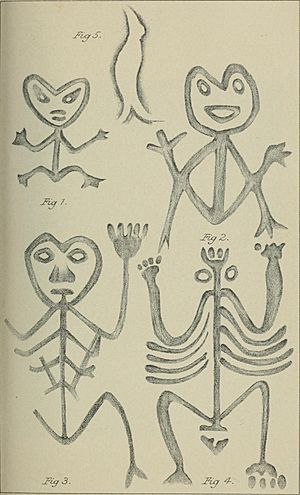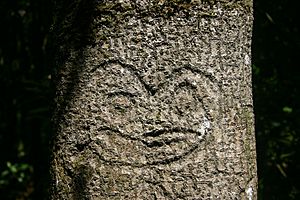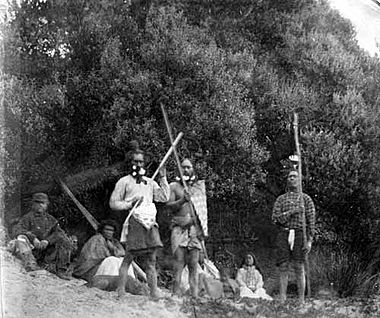Moriori facts for kids

Moriori family c. 1910
|
|
| Total population | |
|---|---|
| approx. 700 | |
| Regions with significant populations | |
| Chatham Islands | 36 (2013 census) |
| North Island | 354 (2013 census) |
| South Island | 348 (2013 census) |
| Languages | |
| Moriori, English, Māori | |
| Religion | |
| Christianity including Rātana | |
| Related ethnic groups | |
| Māori people, other Polynesian peoples, Austronesian peoples |
|
The Moriori are the original Polynesian people of the Chatham Islands. These islands are called Rēkohu in the Moriori language and Wharekauri in Māori.
The Moriori people came from Māori settlers who arrived from mainland New Zealand around the year 1500. Over many centuries, their culture changed and became unique. They developed their own language, stories, art, and way of life. Today, about 700 people identify as Moriori. Most of them no longer live on the Chatham Islands.
Early Moriori groups followed Polynesian customs. Later, they developed a strong pacifist culture. This was called the law of nunuku, based on the teachings of a 16th-century Moriori leader named Nunuku-whenua. This peaceful way of life made it harder for them when Taranaki Māori invaders arrived in the 1830s. During the Musket Wars, the Moriori were attacked, killed, or enslaved by members of the Ngāti Mutunga and Ngāti Tama tribes. This terrible event is sometimes called the Moriori Genocide. About 95% of the Moriori people were killed or enslaved.
However, the Moriori people were not wiped out. Over the next century, they gained respect and were recognized as New Zealand's second indigenous people. Their culture and language have been brought back to life. In February 2020, the New Zealand government signed a treaty with Moriori leaders. This treaty gave them legal rights, an apology, and returned the remains of those killed. The government also gave them NZD$18 million to help their community.
Contents
History of the Moriori
Where the Moriori Came From
The Moriori people are ethnically Polynesian. They created their own special Moriori culture on the Chatham Islands. They learned to live with the local conditions there. While some once thought they came directly from tropical Polynesian islands, research now shows that their ancestors were Māori Polynesians. They moved to the Chatham Islands from mainland New Zealand around 1500.
This idea is supported by how the Moriori language is similar to the Māori dialect spoken by the Ngāi Tahu tribe. It is also supported by comparing Moriori family histories (hokopapa) with Māori family histories (whakapapa). The word Moriori means "true, real, genuine" and is related to the Māori word Māori, which also means "ordinary people."
Adapting to Island Life
The Chatham Islands are colder and less welcoming than the land the first settlers left. Even though there was plenty of food, it was different from what they were used to. The islands were not good for growing most Polynesian crops. So, the Moriori became hunter-gatherers. They mostly ate food from the sea, like fish, fur seals, and young sea birds. The islands could support about 2,000 people.
The Moriori did not have important cultural materials like greenstone or lots of timber. So, they carved dendroglyphs (pictures cut into tree trunks) called rakau momori. Most Moriori dendroglyphs show human shapes. Some also show fish and birds. Some of these carvings are now protected at the JM Barker (Hapupu) Historic Reserve.
Because they were a small group, the Moriori chose a peaceful way of life. They strictly avoided war. Instead, they settled disagreements with ritual fighting and talking things out. This ban on war and cannibalism is credited to their ancestor Nunuku-whenua.
This peaceful approach helped the Moriori save their limited resources in the harsh climate. It prevented the waste that war would cause. However, not being trained in warfare also made them vulnerable later on.
European Contact (1791–1835)
The first Europeans to meet the Moriori were the crew of HMS Chatham. This happened on November 29, 1791. The ship's captain, William Robert Broughton, named the islands after his ship. He claimed them for Great Britain. The Europeans landed in Kaingaroa Harbour.
At first, the Moriori went into the forest. Later, they came out to meet the Europeans. A small fight happened, and one Moriori person was shot and killed. Both sides later said they regretted what happened.
This regret helped create good relations when more ships arrived between 1804 and 1807. These were sealers from Sydney. The Moriori gained a reputation for being friendly. During this time, at least one Moriori visited New Zealand and learned about the Māori. Sealers and whalers soon made the islands a busy place. They competed with the Moriori for resources. Pigs and potatoes were brought to the islands. However, the seals, which were important to the Moriori, were almost all hunted to extinction. European men also married Moriori women.
By the mid-1830s, the Moriori population was about 1,600. About 10% to 20% had died from diseases like the flu.
Invasion by Taranaki Māori (1835–1868)
In 1835, some Ngāti Mutunga and Ngāti Tama Māori from the Taranaki region invaded the Chathams. On November 19, 1835, a ship called the Lord Rodney arrived. It carried 500 Māori people with guns, clubs, and axes. Another 400 Māori arrived on December 5, 1835. Before the second group arrived, the invaders killed a 12-year-old girl.
With the arrival of the second group, Māori warriors walked through Moriori lands. They told the Moriori that their land was taken. The Moriori living there were now servants.
Moriori elders held a meeting (a hui) at Te Awapatiki. They knew the Māori did not share their peaceful ways. Still, two chiefs, Tapata and Torea, said that the law of Nunuku must be followed. The council decided to choose peace. However, the invading Māori thought this meant the Moriori were preparing for war. This led to a terrible attack. Many Moriori were killed, especially in the Waitangi area. The survivors were enslaved.
A Moriori survivor later said: "[The Māori] began to kill us like sheep... We were terrified, fled to the bush... It was no use; we were found and killed – men, women and children." A Māori conqueror said: "We took control... and we caught all the people. Not one escaped." The invaders killed about 10% of the Moriori population.
During the enslavement, the Māori invaders stopped the Moriori from speaking their own language. They forced Moriori to damage their sacred places. Moriori were not allowed to marry other Moriori or Māori, or to have children together. However, many Moriori women had children with their Māori masters. By 1862, only 101 Moriori were left alive out of about 2,000 people. This makes the Moriori Genocide one of the deadliest events in history.
Moriori Today
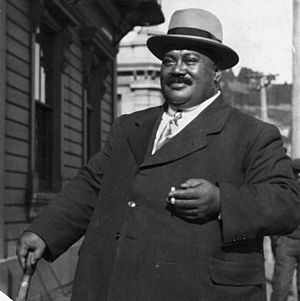
The Moriori were freed from slavery by the late 1860s. This gave them a chance to rebuild their lives. However, their small population meant their culture slowly faded. Only a few men still understood the Moriori language and culture from before the invasion. The younger generation spoke Māori, but still saw themselves as Moriori.
Even though the last Moriori of pure ancestry, Tommy Solomon, died in 1933, there are thousands of Moriori descendants alive today.
Waitangi Tribunal Claim
In the late 1980s, some Moriori descendants made claims against the New Zealand government. They went to the Waitangi Tribunal. This Tribunal looks into claims by Māori about things the government did or did not do since 1840. These actions might have broken promises made in the Treaty of Waitangi. This was the first time the Tribunal had to choose between claims from two different indigenous groups.
The main points of the claim were:
- The British taking over the islands in 1842.
- The government not acting when Moriori were kept as slaves.
- The Native Land Court giving 97% of the islands to Ngāti Mutunga in 1870.
In 2017, the Tribunal's findings led to an $18 million agreement between the government and the Moriori people.
Culture and Marae
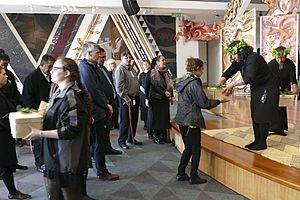
Today, the Moriori culture is coming back to life. This is happening on the Chatham Islands and in mainland New Zealand. A special moment was the renewal of the Covenant of Peace at the new Kōpinga marae in January 2005. A marae is a meeting place for Māori and Moriori people. The Kōpinga marae is in Waitangi on Chatham Island.
As of 2016, the marae has almost 800 registered Moriori descendants. More than 3,000 children are also connected to it. In 2001, work began to save the Moriori language and songs. They also received a $6 million grant from the government to help with this.
The Albatross bird is still important in Moriori culture. Its design is seen at the Kōpinga marae. Its feathers are worn in the hair of some Moriori as a sign of peace. The relationship between the Moriori and Ngāti Mutunga is getting better. Non-violence remains a key part of the Moriori identity.
In 2002, the government bought land on Chatham Island called Taia. It is now a reserve. It is managed by both Moriori and the government. The Moriori are also working to protect the rakau momori (tree carvings) on the islands.
Language of the Moriori
Today, Moriori people speak English and some Māori. The original Moriori language is now extinct. It was an Eastern Polynesian language. It was closely related to Māori and Cook Island Māori. People speaking these languages could mostly understand each other. About 70% of its words were the same as Māori. However, there were big differences in its grammar and how words were said. Efforts are now being made to create learning materials to help keep what remains of the language alive.
Moriori Political Group
In 2001, the two main Moriori political groups joined to form the Hokotehi Moriori Trust. The New Zealand Government recognizes this trust as the main group representing Moriori in treaty talks. It also represents Moriori in matters related to fishing rights and resource management. The trust is managed by ten trustees. They represent Moriori from the Chatham Islands, North Island, and South Island. Its main office is in Owenga on Chatham Island.
See also
 In Spanish: Moriori para niños
In Spanish: Moriori para niños


